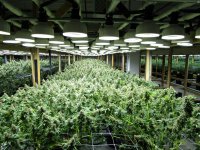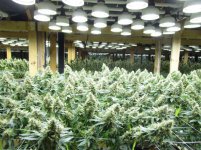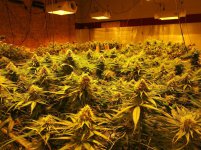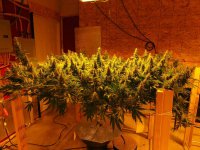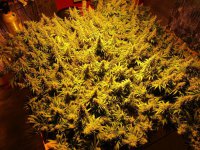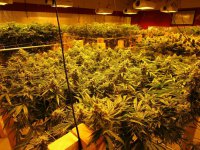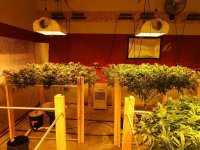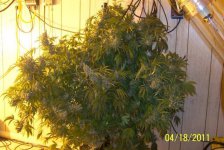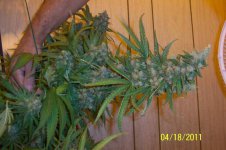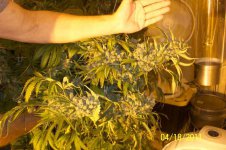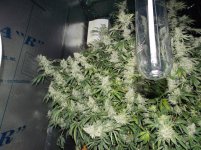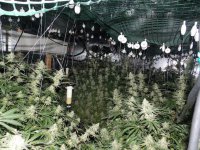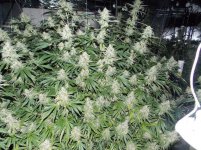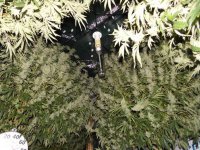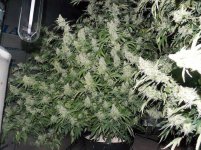as i mentioned in my intro, i am the inventor of the ppk hydroponic system.
for those unfamiliar with the system it is a combination top fed flood and drain combined with a wick system.
here is a brief technical description i wrote:
A system for plant cultivation consisting of a plant module comprised of an upper container (plant container) for the media and plant, resting upon a lower container which acts as an individual plant reservoir for water and nutrients.
The two containers are connected by a tube attached to the top plant container that is filled with the same media as the plant container.
The media is retained in the tube by a grating at the bottom of the tube.
The tube protrudes from the bottom of the plant container downward into the reservoir container through a hole in the top of the reservoir container.
The bottom end of the tube is constantly immersed in the solution in the lower container providing the plant continuous access to the nutrient solution via the capillary rise capability of the chosen medium.
There is maintained an “air gap” in the reservoir container below each plant.
This “air gap” is an air space in the lower container defined by the water level in this container and the bottom of the plant container.
Typically, with most choices of media the “air gap” should be set at 4-5”.
The perched water table exists on top of the water level in the tube.
The tube from the top plant container protrudes through this air space and into the nutrient solution.
The “air gap” allows the “perched water table” from the plant container to move downward into the tube thereby greatly reducing its volume.
This is because the perched water table exists at the same level or height in any given media regardless of container shape or size.
Therefore, a perched water table in a conventional 5 gallon container occupying approximately 1.5” of the bottom of the container approximately 10” in diameter has a volume of approximately 64 ounces.
The appropriate size tube for a 5 gallon container is 2”. Using the same math we find that the pwt, once moved downward into the tube, occupies a total volume of 2.56 ounces or 4 % of the original volume.
This allows watering with much greater frequency. Watering with greater frequency stimulates plant metabolism.
The “perched water table” is a layer of water containing no air that exists in the bottom of most plant containers immediately after each watering event.
The volume of the pwt in a plant container is a direct function of the particle size of the medium. The finer the particle size distribution the greater the volume of the pwt.
Most commercial plant media choices will produce a pwt immediately after watering.
The pwt can only be eliminated by plant transpiration and evaporation. This can take many hours or even days to accomplish.
This is why you cannot water a plant in a conventional container until it nearly dries out. Too frequent of a watering schedule in conventional containers drowns the plant and/or restricts growth due to hormonal down regulation.
In this design we greatly increase both the frequency and volume of the watering events. We are allowed to do so because we are removing the pwt from the plant container after each watering event.
This increase in frequency accomplishes multiple benefits.
We are refreshing nutrients and ph in the rhizosphere or root zone. Keeping these parameters within a more ideal band than a conventional container can.
We are removing old gases from the root zone and introducing new. Primarily removing co2 and refreshing o2.
The device is irrigated via two methods, providing a tremendous redundancy factor in irrigation and ensuring that harvest schedules can be met without crop failure due to lack of water or nutrients.
The device is top irrigated via a reservoir and pump sending nutrient solution to a watering ring or halo placed at the top of the medium and sub irrigated by the tube protruding into the individual plant reservoirs below each plant.
The tube acts as a drain for excess solution during top watering events and moves solution upwards against the force of gravity via capillary rise between top watering events.
The result is that the plant is presented with an ideal band of growing parameters in the root zone at all times.
This above combination of treatments and effects creates a synergistic plant response that allows the plant to grow without the normal negative hormonal feedback issues that affect plants under water stress events.
Controlling moisture content in most plant containers is a function of watering timing and duration.
Because of the existence of the pwt the conventional container must be almost completely dried down to avoid over watering.
In the conventional container the medium is very wet immediately after watering and very dry right before the next event.
Nutrients cannot be taken up by the plant without the presence of water.
After each watering event gravity grades the moisture profile of the medium. It is drier at the top and wetter at the bottom.
In this device we top irrigate with a frequency sufficient to disrupt the moisture distribution curve thereby keeping the medium more evenly wet than a conventional container over longer periods of time.
This keeps the moisture content and chemical parameters of the container in a constant state of flux, continuously refreshing the interface of water, ph, nutrients, and air.
In this device, unlike conventional containers, we have three tools with which to precision adjust and control moisture content in the root zone.
The first is the duration of each event controlling the total volume delivered.
Second is the interval between events controlling the drying rate.
And lastly, the water level in the individual plant reservoirs under each plant can be controlled by a float valve level control in a master reservoir that feeds the individual plant reservoirs.
This ability to fine tune the overall water level in the system precision sets the total water distribution curve in the plant containers, allowing the operator to make the entire system operate drier or wetter as desired.
The overall system is a recirculating, closed loop fertigation system with no drain to waste comprised of a master reservoir that is fed by gravity from an elevated volume tank that is premixed with nutrients.
The solution is fed to the recirculating part from the volume tank on demand through float valves as the solution is used by the plants or evaporated.
The nutrient strength is determined by the rate of use and in practice can be balanced precisely so that consumption of nutrients is stable at all times.
We are feeding a stable, premixed solution to a stable, premixed solution so that there is extreme long-term solution stability.
This is in contrast to most recirculating plant cultivation schemes that require either frequent nutrient changes or expensive nutrient dosing technology.
The solution is recirculated by a pump or pumps that move solution from the supply side of the system to the return side in an arterial/venal fashion.
The pumps only operate long enough to deliver a pulsed application of solution to the top of the medium. Typical pump runtime is 6 minutes per day.
When the pumps fire the prescribed amount of solution is delivered from the supply side of the system in a short burst, typically 15 seconds.
This brings the water level in the supply side down. Gravity immediately begins leveling the supply side by drawing solution from the master reservoir.
At the same time, the solution that is applied to the top of the medium travels through the medium and on through the tube into the individual plant reservoirs below each plant. This brings the solution level up in the return side up and gravity immediately begins to bring the level down again.
The system is basically self-leveling after each irrigation event. The only energy input required for full recirculation are very energy efficient aquarium type pumps running typically only 6 minutes per day.
for those unfamiliar with the system it is a combination top fed flood and drain combined with a wick system.
here is a brief technical description i wrote:
A system for plant cultivation consisting of a plant module comprised of an upper container (plant container) for the media and plant, resting upon a lower container which acts as an individual plant reservoir for water and nutrients.
The two containers are connected by a tube attached to the top plant container that is filled with the same media as the plant container.
The media is retained in the tube by a grating at the bottom of the tube.
The tube protrudes from the bottom of the plant container downward into the reservoir container through a hole in the top of the reservoir container.
The bottom end of the tube is constantly immersed in the solution in the lower container providing the plant continuous access to the nutrient solution via the capillary rise capability of the chosen medium.
There is maintained an “air gap” in the reservoir container below each plant.
This “air gap” is an air space in the lower container defined by the water level in this container and the bottom of the plant container.
Typically, with most choices of media the “air gap” should be set at 4-5”.
The perched water table exists on top of the water level in the tube.
The tube from the top plant container protrudes through this air space and into the nutrient solution.
The “air gap” allows the “perched water table” from the plant container to move downward into the tube thereby greatly reducing its volume.
This is because the perched water table exists at the same level or height in any given media regardless of container shape or size.
Therefore, a perched water table in a conventional 5 gallon container occupying approximately 1.5” of the bottom of the container approximately 10” in diameter has a volume of approximately 64 ounces.
The appropriate size tube for a 5 gallon container is 2”. Using the same math we find that the pwt, once moved downward into the tube, occupies a total volume of 2.56 ounces or 4 % of the original volume.
This allows watering with much greater frequency. Watering with greater frequency stimulates plant metabolism.
The “perched water table” is a layer of water containing no air that exists in the bottom of most plant containers immediately after each watering event.
The volume of the pwt in a plant container is a direct function of the particle size of the medium. The finer the particle size distribution the greater the volume of the pwt.
Most commercial plant media choices will produce a pwt immediately after watering.
The pwt can only be eliminated by plant transpiration and evaporation. This can take many hours or even days to accomplish.
This is why you cannot water a plant in a conventional container until it nearly dries out. Too frequent of a watering schedule in conventional containers drowns the plant and/or restricts growth due to hormonal down regulation.
In this design we greatly increase both the frequency and volume of the watering events. We are allowed to do so because we are removing the pwt from the plant container after each watering event.
This increase in frequency accomplishes multiple benefits.
We are refreshing nutrients and ph in the rhizosphere or root zone. Keeping these parameters within a more ideal band than a conventional container can.
We are removing old gases from the root zone and introducing new. Primarily removing co2 and refreshing o2.
The device is irrigated via two methods, providing a tremendous redundancy factor in irrigation and ensuring that harvest schedules can be met without crop failure due to lack of water or nutrients.
The device is top irrigated via a reservoir and pump sending nutrient solution to a watering ring or halo placed at the top of the medium and sub irrigated by the tube protruding into the individual plant reservoirs below each plant.
The tube acts as a drain for excess solution during top watering events and moves solution upwards against the force of gravity via capillary rise between top watering events.
The result is that the plant is presented with an ideal band of growing parameters in the root zone at all times.
This above combination of treatments and effects creates a synergistic plant response that allows the plant to grow without the normal negative hormonal feedback issues that affect plants under water stress events.
Controlling moisture content in most plant containers is a function of watering timing and duration.
Because of the existence of the pwt the conventional container must be almost completely dried down to avoid over watering.
In the conventional container the medium is very wet immediately after watering and very dry right before the next event.
Nutrients cannot be taken up by the plant without the presence of water.
After each watering event gravity grades the moisture profile of the medium. It is drier at the top and wetter at the bottom.
In this device we top irrigate with a frequency sufficient to disrupt the moisture distribution curve thereby keeping the medium more evenly wet than a conventional container over longer periods of time.
This keeps the moisture content and chemical parameters of the container in a constant state of flux, continuously refreshing the interface of water, ph, nutrients, and air.
In this device, unlike conventional containers, we have three tools with which to precision adjust and control moisture content in the root zone.
The first is the duration of each event controlling the total volume delivered.
Second is the interval between events controlling the drying rate.
And lastly, the water level in the individual plant reservoirs under each plant can be controlled by a float valve level control in a master reservoir that feeds the individual plant reservoirs.
This ability to fine tune the overall water level in the system precision sets the total water distribution curve in the plant containers, allowing the operator to make the entire system operate drier or wetter as desired.
The overall system is a recirculating, closed loop fertigation system with no drain to waste comprised of a master reservoir that is fed by gravity from an elevated volume tank that is premixed with nutrients.
The solution is fed to the recirculating part from the volume tank on demand through float valves as the solution is used by the plants or evaporated.
The nutrient strength is determined by the rate of use and in practice can be balanced precisely so that consumption of nutrients is stable at all times.
We are feeding a stable, premixed solution to a stable, premixed solution so that there is extreme long-term solution stability.
This is in contrast to most recirculating plant cultivation schemes that require either frequent nutrient changes or expensive nutrient dosing technology.
The solution is recirculated by a pump or pumps that move solution from the supply side of the system to the return side in an arterial/venal fashion.
The pumps only operate long enough to deliver a pulsed application of solution to the top of the medium. Typical pump runtime is 6 minutes per day.
When the pumps fire the prescribed amount of solution is delivered from the supply side of the system in a short burst, typically 15 seconds.
This brings the water level in the supply side down. Gravity immediately begins leveling the supply side by drawing solution from the master reservoir.
At the same time, the solution that is applied to the top of the medium travels through the medium and on through the tube into the individual plant reservoirs below each plant. This brings the solution level up in the return side up and gravity immediately begins to bring the level down again.
The system is basically self-leveling after each irrigation event. The only energy input required for full recirculation are very energy efficient aquarium type pumps running typically only 6 minutes per day.
